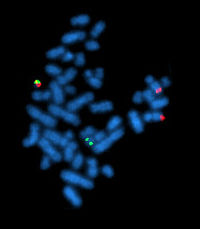
Photo from wikipedia
Acute myeloid leukemia (AML) in children refers to a malignant tumor caused by the abnormal proliferation of immature myeloid cells in the bone marrow and peripheral blood. The prognosis of… Click to show full abstract
Acute myeloid leukemia (AML) in children refers to a malignant tumor caused by the abnormal proliferation of immature myeloid cells in the bone marrow and peripheral blood. The prognosis of patients with pediatric acute myeloid leukemia (AML) remains poor, highlighting the need for improved targeted therapy. The expression data of lncRNAs, mRNAs, and miRNAs and survival information of pediatric AML patients were collected from The Cancer Genome Atlas (TCGA) database. Cox regression analysis was used to screen the lncRNAs, mRNAs, and miRNAs that significantly affect the overall survival (OS) of patients as OS-related genes (included lncRNAs, mRNAs, and miRNAs). Enrichment analysis and protein-protein interaction (PPI) network construction were performed for the OS-related mRNAs. We further established a ceRNAs regulatory network. In addition, the potential prognostic role of genes was further evaluated by risk score. We have identified 5275 lncRNAs, 176 miRNAs, and 6221 mRNAs that significantly affect the prognosis of pediatric AML patients. It is worth noting that OS-related mRNAs are mainly involved in ribosome, RNA transport, and spliceosome. We identified the top 10 most connected mRNAs in the PPI network as important mRNAs and constructed a ceRNAs regulatory network (including NCBP2, RPLP0, UBC, RPS2, and RPS9). The risk score and nomogram results suggest that NCBP2 may be a risk factor for pediatric AML, while RPLP0, UBC, RPS2, and RPS9 may be protective factors. Our results construct 5 gene signals as new prognostic indicators for predicting the survival of pediatric AML patients. Our research has demonstrated the ceRNAs regulatory network may become a new target for pediatric AML treatment.
Journal Title: Journal of Healthcare Engineering
Year Published: 2022
Link to full text (if available)
Share on Social Media: Sign Up to like & get
recommendations!